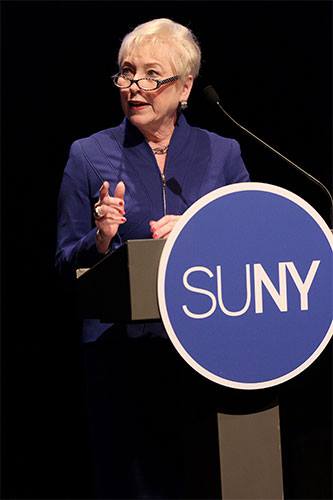
On Thursday, Nov. 6, the State University of New York (SUNY) administration approved the fifth year of the rational tuition increase.
This is a part of the SUNY 2020 plan agreed to in 2011 by Gov. Andrew Cuomo and the legislature which allowed the 64 SUNY schools to be able to raise tuition without having to get approval from the legislature every year.
“The current tuition system does not serve our students, schools or state,” Cuomo said when the bill was released in 2011. “This bill brings rationality to the SUNY tuition system by allowing students and parents to reasonably plan for college expenses, instead of being subject to dramatic tuition increases and uncertainty.”
The tuition for the 2015-16 school year for in-state residents will be $6,470.
SUNY New Paltz Vice President of Enrollment Management L. David Eaton said the rational tuition increase is a fairer system of increasing tuition because there were times when students went the duration of their time at a SUNY school without seeing a tuition increase.
“Basically what you have is a situation where students who come at the wrong time are making up and subsidizing students who came before them that really didn’t pay their fair share,” Eaton said.
Eaton also said that in the ‘80s, 90 percent of the college’s operating fee came from New York State tax revenue. Now, 25 percent comes from tax revenues and the majority comes from tuition fees.
Fourth-year administration management major Jesse Hicks, an executive committee representative of the SUNY student assembly, said it is important for students to understand this policy isn’t coming from the college.
“People need to understand the macro and micro perspectives of this and know this isn’t something [SUNY New Paltz President] Donald Christian is coming out with and saying rational tuition [is the new policy]. This is something coming from SUNY,” Hicks said.
The increased tuition in 2015-16 will increase SUNY’s budget to $2 billion. Eaton said these new funds will pay for hiring more full-time faculty and professors and go towards the negotiated salary increases of the college’s union workers.
Students who receive money from the Tuition Assistance Program (TAP) will receive increased assistance, Eaton said.
“TAP is tied to the cost of tuition, so increases are covered in the supplemental TAP grants for students with TAP awards and those supplemental awards are paid directly out of the tuition increase money,” he said.
Eaton said the increased cost of tuition has not impacted the number of applications the college receives. He said New Paltz has received the highest number of applications in SUNY 25 years in a row, and this year is looking to be no different.
While the college’s application numbers haven’t gone down, Eaton said he is still cautious about raising fees.
“Every $300 makes a difference to somebody. Students and their families have to struggle to meet the demands of paying for college today, much more than in the past,” Eaton said. “That’s why students need to come here, study hard, graduate on time and learn the things they need to learn to be successful.”
Eaton said that a misconception among students is that the construction being done on campus is coming from tuition money, but the construction is paid for through bonds the college receives. Only the residence halls are paid for with room fees because they are self-sufficient, he said.
Hicks said it will be interesting to see how SUNY will determine whether the rational tuition policy was effective and what their proposed plans of increasing tuition will be in the future. He also said the executive committee will continue to advocate for better tuition rates and to educate the students of SUNY on rational tuition increases.
Being the fifth year of the rational tuition plan, Eaton said he is unsure going forward when tuition will increase again. He said it will depend on New York State’s unemployment rate and the health of the state’s economy.
